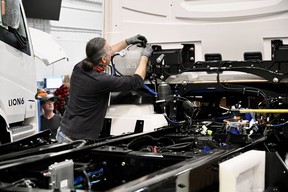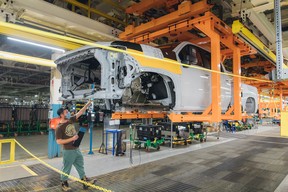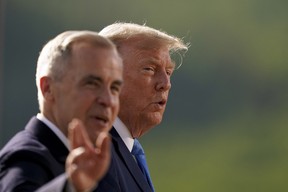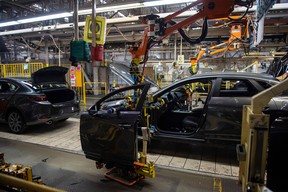Lorraine Explains: Could American-car boycotts extend to The Big Three?
General Motors, Ford, and Stellantis may be poised to throw Canadian manufacturing under the bus—is there a case we should do the same to them?

Article content
How soon until Canadians start boycotting The Big Three? Okay, okay: “The Detroit Three.” I call Ford, General Motors, and Stellantis “The Medium Three” myself, now. You can’t look at what is happening across the globe in the automotive sphere and conclude that any of them are still a dominant force. So, yeah, “big” they are not. Worse yet, if U.S. President Donald Trump has his way, he will protectionism them to even greater irrelevance. The U.S. may not think it needs cars made in Canada, but the rest of the world doesn’t need American cars either.
My colleague David Booth teed up an open letter to tariff-negotiator-in-chief Prime Minister Mark Carney to ask him to reflect on the duty remissions currently being tossed around to dodge or hobble the U.S. tariffs we are certain to get nailed with. “The most effective complication would be a credit system that allows those who build more cars in Canada than they import from the United States — Toyota and Honda by far being the most prolific examples — to sell credits to other automakers with no manufacturing here,” wrote Booth. Build more here, hold more cards. Makes sense.
Over at the Toronto Star last week, business columnist David Olive re-imagined the entire Canadian automotive landscape. He says the bad part out loud: if Trump wants to eradicate Canadian passenger- and light-vehicle production, it wouldn’t be hard to do it. “The Ontario-based vehicle assembly industry is still considered to be the heart of Canada’s manufacturing sector. Yet it has shrunk by 55% since 2000, when it produced 2.9 million vehicles. Production fell by 13% last year.” I don’t often quote our media competitors, but Olive makes some great points.

Olive’s suggestion is a Plan B: “[A] Canadian auto sector that goes its own way would become the leading supplier of trucks and other vehicles to all orders of government in Canada, from municipalities to the Canadian Armed Forces. It would also make heavy equipment for the Canadian farming, construction, mining, and forestry sectors, almost all of which is currently imported.”
Production in those sectors wouldn’t currently correct for the loss of GM and Stellantis manufacturing (their combined production in 2024 [though already falling this year] was 311,360 units) but with talk of expanded military investment, Olive’s idea is a good start, in the spirit of shopping at home for Canadian-made options. The mining industry already sports some world players. There have also been rumblings of creating a “Canadian” car, building on something like the Project Arrow EV, created by the Automotive Parts Manufacturers’ Association. Perhaps a local billionaire could step up, as that seems to be how the world works now.
American auto manufacturers have pretty much signalled to Trump, like so many institutions and industries in that country, that they’ll cave to the forces that will render the U.S. perhaps the powerhouse they imagine (I can’t imagine this coming true) but also a global pariah (I can imagine this). Mary Barra at General Motors has been disturbingly enthusiastic about reconfiguring her company in a way that throws Canada under the bus. Several months ago, GM in Oshawa laid off 750 workers making Chevy Silverados at the same time Barra announced the addition of a shift in Indiana making—Chevy Silverados. GM recently announced its profits will take a hit of between US$4 billion and $5 billion, but Barra is cool with that. Canada should be alarmed.

Stellantis assembles minivans and Dodge Charger EVs here, in Windsor, Ontario, though what’s happening with its Brampton plant is anyone’s guess; and a year ago, Ford announced a USD$3 billion boost to expand production of its F-Series Super Duty trucks in Oakville and the Essex engine plant. Will that still happen? My money is on Ford not coming back, and Stellantis skedaddling forthwith. Booth muses on the elephant in the room, namely allowing Chinese automakers to produce cars in Canada: “We’re probably better off with General Motors, Ford, and Stellantis as partners than [Chinese makers] BYD and Xpeng. But the bottom line has to be that we want someone producing vehicles here in the Great White Frozen North.”
The U.S. owns the companies, Mexico filled in the super-cheap labour, and Canada was thrown a bone with well-paying jobs propped up by government-supplied healthcare. Combine that with ever-increasing federal loans (and bailouts) that over time turned into grants that didn’t stop manufacturing from closing up shop anyway. Canada’s modern auto industry has always been caught between securing high-paying jobs and relying on the kindness of foreign owners.
American auto manufacturers have signalled to Trump that they’ll cave to the forces that will render the U.S. perhaps the powerhouse they imagine (I can’t imagine this coming true) but also a global pariah (I can imagine this)
The North American Auto Industry Since NAFTA was published this year by Greig Mordue, Program Lead, Master of Engineering and Public Policy with the W. Booth School of Engineering Practice and Technology at McMaster University; and Dimitry Anastakis, Professor, L.R. Wilson/R.J. Currie Chair in Canadian Business History, Department of History, University of Toronto. Prior to joining McMaster, Dr. Mordue was General Manager of Toyota Motor Manufacturing Canada (TMMC), responsible for Corporate Planning and External Affairs.
One chapter especially, written by Mordue with Brendan Sweeney, the managing director of the Trillium Network for Advanced Manufacturing, captures with some prescience what is happening now, and how Trump’s tariffs absolutely have the ability to shake this industry to its core, if not destroy it. “The Stratification of the Global Auto Industry: North America as the Archetype” lays out the devastating consequences of decades of negotiations by various parties in power to massage Canada’s auto industry to the point where it can be broken by an administration we have no control over.
The book was published earlier this year, and Mordue indicates some parts of it are outdated, like those concerning the proposed establishment of battery plants in Ontario. Trump’s stated goal is to repatriate all production to the U.S., but that only points to high-cost partner countries that mainly export to the U.S., like Canada, getting the boot first.

Here’s the broad strokes that should form the backbone of concern for current negotiations. Since 2000, the auto industry has sorted itself into three strata.
- Core automotive countries (including the U.S., Germany, and Japan): they derive power and competitive advantage by hosting the headquarters of automakers. They retain most R&D and high levels of production;
- Integrated Peripheries (including Mexico, countries in Central and Eastern Europe, North Africa, and Thailand): their main advantage is low-cost labour; and
- Semi-Periphery (including Canada, Spain, the U.K., Belgium, Austria, Sweden): no homegrown automakers here, nor do they offer low-cost labour. This had led the sector to struggle to secure mandates for R&D or secure production.
“Semi-Peripheries possess neither the market power nor the residual power derived from the Core’s role of hosting the headquarters of a global product leader. Moreover, they now find themselves increasingly squeezed by the offer of low-cost labour associated with their emergent Integrated Periphery competitors,” reads the Mordue and Sweeney chapter. The recession of 2008 and ’09 and the COVID-19 pandemic were speed bumps compared to the upheaval threatened by Trump’s tariffs.
Canadians who work on the assembly lines of the auto industry know the truth: it’s been collapsing around their ears for over two decades. NAFTA was no boon to the auto industry, as it simply left Canada standing around holding its stickshift in its hand.

“By 2008 – on the eve of the recession, rather than a consequence of it – vehicle production in Mexico eclipsed vehicle production in Canada. By 2019, Mexico’s share of North American production was almost twice that of Canada. Thus, during the post-2000 period, Mexico absorbed virtually all of the vehicle production losses experienced by its northern neighbours,” explain Mordue and Sweeney. “During that time, the effect on Canada was disproportionate to that experienced by the U.S. In effect, Mexico dislodged Canada as the North American automotive industry’s low-cost Integrated Periphery.”
David Booth and David Olive are both right. Automakers like Honda and Toyota will need to be wined and dined in a quest to ensure they remain loyal to Canada for as long as it’s conceivable to do so. As for The Medium Three? I think they’re already gone.
American automakers have made peace with the tariffs. There seems to be no room for Canada in that tent. Trump has given GM, Ford, and Stellantis a get-out-of-Canada-free card. As world trade pivots to the musings of a madman, will they take it? And if they do, will “elbows up” move beyond groceries and Vegas getaways—and into the American-branded cars we buy on this side of the border?
Sign up for our newsletter Blind-Spot Monitor and follow our social channels on X, Tiktok and LinkedIn to stay up to date on the latest automotive news, reviews, car culture, and vehicle shopping advice.















Postmedia is committed to maintaining a lively but civil forum for discussion. Please keep comments relevant and respectful. Comments may take up to an hour to appear on the site. You will receive an email if there is a reply to your comment, an update to a thread you follow or if a user you follow comments. Visit our Community Guidelines for more information.